K3b
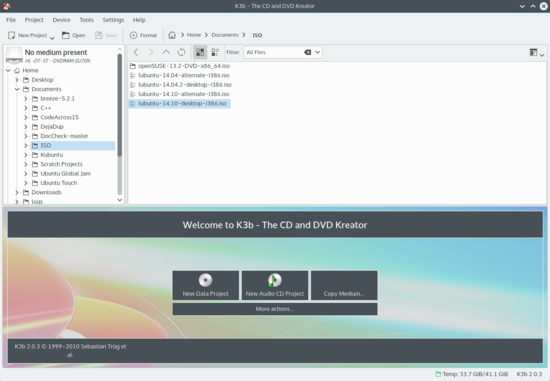 |
Introduction
If you have used a burning program such as Nero under Windows, K3b will feel quite familiar.
Featuring a simple, yet powerful graphical interface, K3b provides various options for burning a CD, DVD, or BD (Blu-ray disc). Various types of optical projects are supported including (but not limited to) audio and data, video projects for DVD and VCD, as well as multi-session and mixed-mode discs. K3b also has the ability to erase re-writable media and can perform more complicated tasks such as audiovisual encoding and decoding.
Pre-setup
When you run K3b for the first time, you may find K3b informing you that no optical writer drivers have been found, meaning you will not be able to write to any optical discs. There is no need to panic as K3b will open the Permissions tab on the Programs page of the configuration dialog, where permissions can now be changed. In all modern systems optical devices belongs to a certain user group (e.g. "cdrom"). If the current user does not belongs to this group, he is offered to add himself to it on this tab.
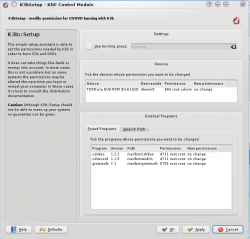
Configuring the User Interface
Upon starting K3b you are offered quick starts to the three most popular processes
- New Data Project
- New Audio CD Project
- Copy Medium
K3b can perform much more than these tasks though, and so you may find that some of the other possibilities are just as useful to you. Take a look at this list for a taste of other available functions (click on the image to enlarge it):
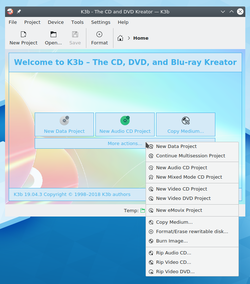
Perhaps a quick start for one or more of these other tasks would be useful to you and so K3b can give you that, too. Simply right click on the application desktop, and here you will see a menu for adding buttons:
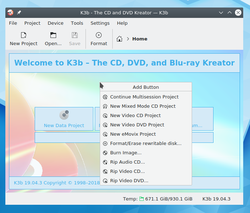
Configuring the internals
Most of the default settings can simply be left alone. It is however, recommended that you do take a look at the Advanced Settings page. Here you can set various important settings, if required.
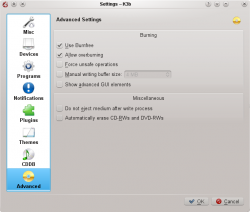
- Use Burnfree should be set — it controls the burn, ensuring that the buffer never gets dangerously low (which reduces the quantity of bad burns).
- You may wish to automatically erase re-writable disks.
- The option Do not eject medium after write process is invaluable if your drive is one that cannot be closed quickly enough for Verify to happen.
Preparing to burn a disk
When starting a new project, you should ensure that K3b has detected the correct optical media, such as CD or DVD. On the status line at the bottom of the screen you should see the size of disk which is currently set. If this is not correct, or you require a different size, simply right-click on it and set the preferred size from the provided list:
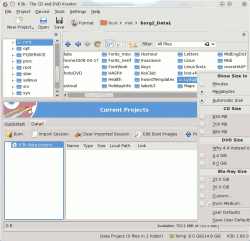
Now choose what is to be burnt.
The top half of the screen is the source pane; it functions like a file manager. You can choose ordinary files from mounted data volumes or audio tracks from inserted audio discs. Names of audio tracks are automatically read from CD-TEXT data, if your CD drive supports reading it, or generated using CDDB; the exact format is controlled by a button in the bottom pane. If the names are incorrect or simply do not match the description of the disc, you can edit them using the toolbar button. Your changes will be cached locally and submitted to the master registry at FreeDB. Internet connection fees apply.
Now that you have your sources at hand, simply drag and drop the files and directories you wish to burn onto the large pane to the right at the bottom; this is the model pane. Behold a tree of your chosen files forming to the left. Should there be some files or directories which you do not want to burn, these can be easily removed from the project by simply removing them from the panel at the bottom. Select the file to be removed (you can control-click to select multiple ones), then choose from the context menu.
The top line will be the title of the disk. In many cases this will be fine, but if you would like to change this to something else, simply rename it using the context menu.
Final Steps
You are now ready to hit the Burn button.
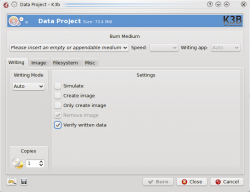
You will see on my screenshot that no disk was present. When you have inserted the appropriate disk you will see a description of it on that line.
There are still one or two choices to be made. I would recommend that you set Verify written data, then hit the Save icon at the bottom of the screen, ensuring that it becomes your personal default. For most modern drives it's safe to leave mode and speed to Auto. If you may wish to burn another copy of the disk at a later date, select Create image, which will save having to set up the burn again. Set the number of copies you want to burn, then, when you are satisfied, hit Burn.
Burning an Audio CD
This page tells you how to burn an audio CD from your stored files.

